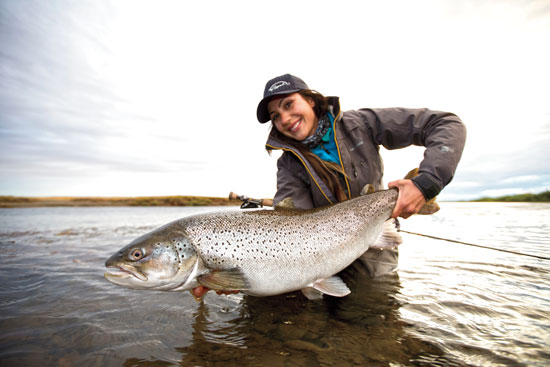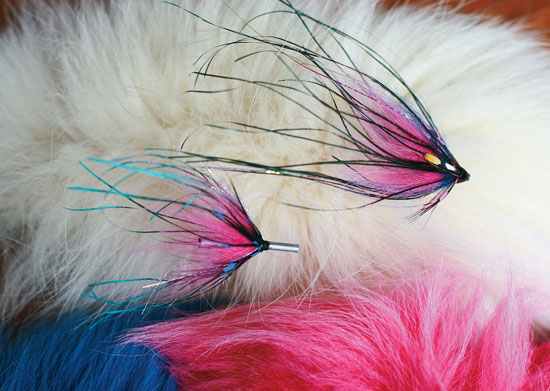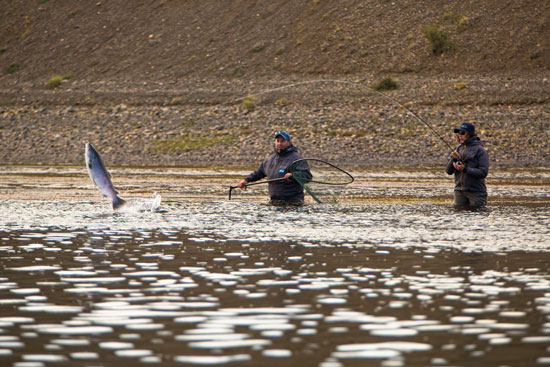March 14, 2014
By Fly Fisherman
[caption id="attachment_17932" align="alignright" width="385" caption="The author's Arctic fox, rhea, and ostrich creations have been eaten by Atlantic salmon, Chinooks on the Dean River, and (here) brown trout in Argentina. Photo: Stephan Dombaj/Fly Fishing Nation"] [/caption]
[/caption]
I remember my first experience with a fly-tying vise. Excited and eager, I pushed in the old VHS tape and squirmed nervously as the VCR whirred and the grainy image of a smiling white-haired man seated behind a desk appeared.
I sat back anxiously waiting to determine whether or not I had the necessary tools to proceed. Vise? Check. Bobbin? Check. Scissors? Check. Thread? Ummm . . . nope. After pressing the pause button, I ran downstairs to dig through my mom's sewing station, and grabbed a spool of black thread. Check.
Watching the man carefully explain the basics of fly tying, I proceeded to pause the tape frequently while running around the house, digging up various items that might suffice as reasonable substitutes for the materials he was using. It was the start of what would soon become a complete obsession with fly tying and all it encompassed; its history, materials, and possibilities.
Learning Process
It was more than a decade ago when I first sat with a group of dedicated steelhead fly fishers and learned the ropes of productive West Coast steelhead flies. The nights were long around the table, and as I watched them tie, I quietly picked scrap
materials off the floor, and paid close attention to those who came back to the house with beaming faces and wet cuffs. It was only a matter of time before I had taken some very basic observations and transformed them into some ideas of my own.
At that time, we were fishing for summer-run steelhead in a winter setting. November and December iced the riverbanks, but the promise of summer steelhead lurking in the nearby pools kept many of us hopeful and fishing determinedly into the setting sun.
Summer steelhead differ from their winter-run relatives in that they enter the system much earlier, and in an immature state. With more time to make their migration, and increased metabolisms due to warmer water, summer-run steelhead have more energy, and a greater tendency to take both swung and dry flies.
Those of us who had strenuously fished with single-handed fly rods made the switch to the double (or Spey), making it easier to turn over heavy flies and sinking tips.
Up until the increasing popularity of Spey rods, the more traditional approach of lighter, smaller flies had been a common preference in the form of simple leeches, Green-butt Skunks, and General Practitioners.
While at the time we didn't have Skagit lines or T-17 shooting heads, Windcutters and mid-belly lines still granted us some ability to present large streamers to migrating fish. With this tackle, steelheaders were able to add more size and creativity into their flies.
We tied flies on cut-off hook shanks that ranged anywhere from 2 to 3 inches long. From here, we tied in a looped and reinforced piece of wire or monofilament, extending the loop just far enough past the shank to allow us to loop on a hook.
This allowed us to switch out a hook when it dulled, bent, or rusted. The style also allowed us to tie lengthy flies with short-shank hooks and preserve our ability to land the fish. Flies on long-shank hooks were always dangerously teetering on the point of untimely self-removal.
[caption id="attachment_17934" align="alignleft" width="231" caption="The best flies for anadromous fish have maximum volume and movement, but sink quickly and are easy to cast. Photo: Diana Siems/ADH-Fishing"] [/caption]
[/caption]
The popularity of this fly pattern grew overnight, and while today it is commonly known as Ed Ward's Intruder, at the time many of us didn't know the fly's name or who had popularized its characteristics. What we did know is that we were certainly catching more fish with them.
Needless to say, it didn't take long for Intruder variations to circulate through steelhead circles in both the West Coast and Great Lakes regions. Before long, anglers all around me on my home rivers had turned in their 9-foot single-hand rods and were practicing the art of Spey casting with large flies.
Tank Trials
A couple years back I purchased a swim tank to help assist, educate, and entertain students at my fly-tying classes. It's a Plexiglas tank with a pump that simulates an artificial current. The flow of water over and through the materials helps you analyze different characteristics of a fly's materials and design.
The swim tank quickly gave me an education on which materials look better in the water, and which ones look best on the shelf. What I learned was that some Intruders were too bulky to cast, or worse, so overdressed they didn't sink quickly.
The goal is always to give the fly enough volume to allow it to dance and pulsate as it swims through the current, but do so with as few materials as possible. Fly design helps achieve this goal.
I use two balls of dubbing for a maximum splayed effect. One goes at the front of the fly, the other in the back, and I wind a single strand of tinsel through the middle to separate them. This design shows the fish something different and still allows for an effortless cast and presentation. I call these sorts of flies "two-steppers."
To achieve the proper volume, there are several different materials that I specifically seek out for my flies. Polar bear, Arctic fox tail, and synthetic Ice Dub are certainly my first choices when looking for materials that are coarse enough to maintain a splayed effect, yet soft enough to move easily in the water. Pre-dubbed brushes can significantly cut down tying time, as standard dubbing can take up to three times longer for many tiers.
From here, I add an overlaying material above the dubbing to contribute length. Again, there are many differing opinions on what works best for this, however for me it is rhea,
ostrich, and marabou. As the long fibers encompass the splayed dubbing, the fly holds its shape and moves with maximum action.
[caption id="attachment_17933" align="alignright" width="297" caption="The front tube uses longer Arctic fox and rhea than the rear tube. A ball of dubbing splays the fibers outward so the flies appear larger, and the materials don't collapse against the tube in the current. Photo: Brian O'Keefe"] [/caption]
[/caption]
Intruder Variations
After Intruders became incredibly popular, it was inevitable and ironic that I would eventually turn back to smaller-profile flies. But rather than lose my arsenal of two-steppers altogether, I simply downsized my flies in half and tied them on tubes, labeling them as basic one-steppers.
I have always been a fan of tube flies. My early days as a young steelheader meant that my paychecks were few and far between, and the price on a package of tantalizing Alec Jackson hooks—which I was only going to destroy—left me seeking cheaper alternatives.
Plastic Q-tips, WD-40 straws, bobby pins . . . I got creative and soon found that as long as I had a package of stinger hooks, I could tie materials on just about anything, so long as it didn't shatter if it hit on the rocks behind me.
While my tying style minimized itself, so did my time at the tying bench. Often in a hurry to tie "guide flies" for the following morning, out of necessity I allowed tube flies to take over my fly box.
Tube flies had some advantages over shanks with loops. The amount of time that it took to tie in the loop; paired with the cost of a material that wouldn't kink, break, or slide; and the cost of the massacred hook shank itself, threw my thrifty self into a tube frenzy.
Using a simple tapered needle, I placed it into the jaws of my standard vise and slid my tube of choice over until it sat snug on the extension. With tubes, my flies were still able to interchange hooks, allow me the leverage of a short shank to land my fish, and they were quick, easy, and affordable.
Gone were the days of cautiously mapping out the placement of stinger wire. In addition to functionality, I no longer had to comply with the rules of "proper" proportions. And as there are no hook eyes on a simple cylinder, an overcrowded head wasn't of any concern. When I finished a fly, I just cut off the excess tubing, saving me time, money, and materials.
Moving forward, I traveled through various steelhead and Atlantic salmon fisheries with a plethora of tubes of all shapes and sizes. Another of the many advantages was the freedom to change out not only damaged hooks but hook sizes as well.
For example, when I fished a river with large Chinook salmon, I could use a 2/0 stinger hook. If I saw a steelhead roll in a slower seam downstream, it took only a matter of seconds to remove the large hook, replace it with a smaller one, and still use the same fly. [On our cover, the author shows off a Chinook salmon caught in the "gut" of a famous steelhead pool. The Editor.]
But with all of the versatility of tube flies, there is one overreaching advantage—they are stackable.
Within no time, I was tying only one-steppers in every color of the rainbow and in two sizes: short (rear one-steppers) and long (front one-steppers), so I could mix and match lengths and colors.
[caption id="attachment_17935" align="alignleft" width="330" caption="Short-shank hooks hold better on high-flying fish like steelhead, salmon, and (yes) brown trout. Photo: Stephan Dombaj/Fly Fishing Nation"] [/caption]
[/caption]
Storing them in a simple Zip-loc bag, I could travel the world with a variety of tubes fit for mixing and matching. If a river is low and clear, I slide one small tube down my leader and secure a small stinger hook with a loop knot (or knot of choice).
If a river is murky or suited for larger flies, I add another one-stepper atop the small one, and allow the current to push them together into what looks like a standard pulsating two-stepper.
By leaving a little excess tubing on the head of the rear portion, it creates enough space between the two segments to provide additional movement.
A small bag of tungsten beads sits in my wader pocket, each bead fitting perfectly atop the excess tubing to provide weight if desired.
When I go fishing for Dolly Varden, I slide on two or three stackers; for steelhead, rainbows, and browns, I use one or two; for pike, four or five; for Chinook I use a chartreuse and a blue stacker; and if I see rolling steelhead, I replace the chartreuse section with a pink one instead.
The mix and match options for colors, sizes, profiles, weights, and species are endless. As long as I have tension by means of current or stripping, my small bag of flies can be transformed into virtually any streamer for the freshwater fishery at hand.
Trip organization for me is no longer dependent on collecting specific flies of various color combinations, profiles, and hook sizes. I now have the possibility of multiple fly patterns and sizes, without being weighed down by several fly boxes filled with flies I would quite likely never even have the opportunity to use.
From my days as a girl scrambling through the house to find substitute materials, to my life now as a woman who tries to leave the constrictions of a very square box, creativity and innovation are now regular visitors to my vise.
Over the years, fly preferences will continue to ebb and flow much like the current that brings them to life, changing from small to large, criticized to accepted . . . it is a cycle that is certain to repeat itself in history, and one that enhances our days on the water.
There are always going to be styles, techniques, and ideas that may not be for everyone, but I urge all fly fishers to at least open their minds to the exploration of new concepts. Sometimes the answer is right at our fingertips, but we are too busy staring at what is already in our hands to clearly see it.
April Vokey owns Fly Gal Ventures (flygal.ca) and is a Patagonia brand ambassador, G.Loomis pro staffer, and member of the RIO Product Advisory Team. She gives fly-casting and fly-tying seminars around the world.
[imo-slideshow gallery=59]

